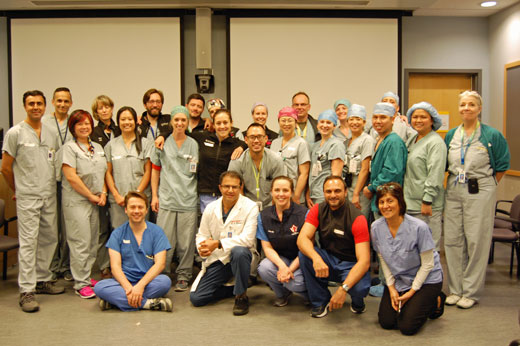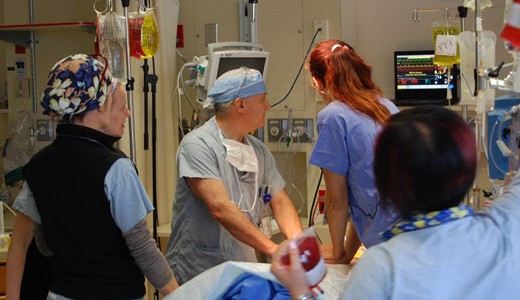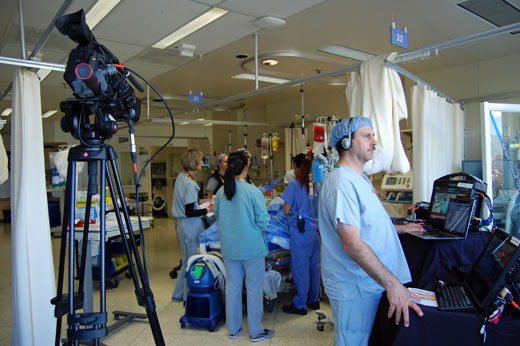“This is the way of the future”
At 8 am on June 17, a 35-year-old patient arrived at the VGH Emergency Department (ED) by ambulance. The paramedics described the patient as a construction worker who had fallen off a roof.
But this wasn’t your typical trauma patient. Actually, he wasn’t really a patient at all.
He was a simulation mannequin and his ‘arrival’ at the ED marked the beginning of a multidisciplinary, multilocation simulation exercise placing our teams at the forefront of medical education.
“Conducting simulations in situ — inside a working hospital — is novel,” says Dr. Silke Brinkmann. “Spanning a simulation across multiple departments is leading edge and a first for VGH.”
Improving patient transitions

More than 40 people, including paramedics, volunteered to participate in the multilocation simulation, the first of its kind at VGH.
The simulation involved three stages in the mock patient’s journey. From the ED, the patient was transferred to the Operating Room (OR) and then to the Post-Anesthesia Care Unit (PACU). Each stage — and especially each transition — put the volunteer participants to the test.
“Transitions can be dangerous points in a patient’s journey,” says Dr. Andrew Sawka, Medical Director, Perioperative Services. “The team designed this simulation to help us understand each other better and work better as a larger team – our patients’ safety depends on this.”
Planning for this unique simulation took several months of work by a dedicated Planning Committee, including many who volunteered their time and came to meetings on days off to participate. Participants were also fortunate to benefit from the expertise of two Emergency Medicine Residents, Drs. Wesley Jang and Nicolle Holm, who are completing fellowships in simulation this year, as well as Dr. Christa Dakin, who is regarded as a national expert in simulation.
Each stage was followed by a debrief to review, enhance learning and share a few laughs. “Team-building is a very important and often unrecognized aspect of simulation exercises,” says Dr. Sawka.
“Learning together, in the moment, strengthens relationships and improves communication, making our delivery of care better and safer.”
A recommended experience
More than 40 people, including paramedics, volunteered to participate in the exercise. Amy Chin, a registered nurse working in PACU, was one of them.
“It validates what we do well, and it lets us practice some very dicey things in a safe environment and controlled situation,” she says.
For Amy, her learnings included a better understanding of the different dynamics in other departments.
“Most of us don’t have a good idea of the flow between departments and how roles work elsewhere in the hospital,” she explains. “The nursing role of an OR RN is very different than the role of an RN in the ED or PACU.”
Asked whether she’d recommend participating to others, she nods yes. “There’s great value in the experience. When you can feel overstretched and overworked, it reminds you of why you do the job you do.”
The future has no limits
“In situ simulation is the way of the future, and we did fantastic for a first run,” says Dr. Brinkmann. “We’ve proven that we can perform complex scenarios safely inside a busy hospital, and I see no limits on what we could test in the future.”
Dr. Badh agrees. “I’m excited about where we can go,” he says. “There’s potential for Vancouver-wide simulations — maybe even VCH-wide simulations.”
Adding, “Within one to two years I can see VGH performing in situ simulations as good as anyone on the planet. One day, people from around the world will want to come to VGH to be a Sim Fellow.”
See it for yourself
Click the play button below to view a two-minute excerpt of participants in the PACU.
Thank you
Special thanks go to all participants and the Planning Committee who so generously shared their expertise and time to make the VGH Interdisciplinary Multistage Simulation a resounding success.
The Planning Committee
- Dr. Oliver Applegarth
- Dr. Tony Badh
- Joanne Beetstra
- Dr. Silke Brinkmann
- Angie Brisson
- Dr. Christa Dakin
- Dr. Sahar Farahmand
- Jaime Gallaher
- Dr. Morad Hameed
- Dr. Nicolle Holm
- Dr. Wesley Jang
- Dr. Emilie Joos
- Nasira Lakha
- May Leung
- Heather Prime
- Dr. Siu Kae Yeong


